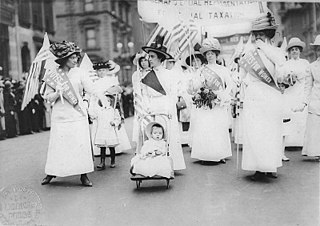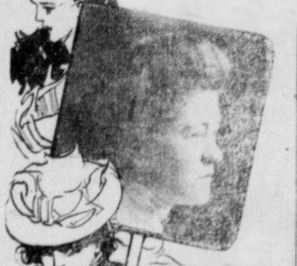History
Christine Ross Barker a Nova Scotian suffragist and Women's International League for Peace and Freedom (WILPF) member, proposed a conference to be held in 1921 with American and Canadian women to discuss outlawing war. The conference, held between August 19 and 21, at Niagara, Ontario spurred the creation of the Women's Peace Union of the Western Hemisphere. The organization called for the immediate disarmament of all nations, and encouraged cooperation of women in Canada, Mexico and the United States to work towards that goal. Barker was the temporary chair, Margaret Long Thomas of New York City was appointed secretary, and Gertrude Franchot Tone of Niagara Falls, New York was the treasurer. [2] Though founded by Canadian women, the organization was based in New York and strove to introduce an Amendment to the Constitution of the United States banning participation in war—the solitary mission of the organization. Caroline Lexow Babcock and Elinor Byrns coordinated the efforts to draft the amendment and to work within the United States political system to outlaw war. WPU campaigned steadily and single-mindedly from 1923 to 1939, along with Senator Lynn Joseph Frazier of North Dakota, for a constitutional amendment that would outlaw war and the preparation for war in the United States and all its territories. [5] WPU refused to negotiate when it came to partial disarmament methods as they completely condemned all acts of violence. [6] From 1926, Rose Henderson, a Canadian social reformer, had become a supporter of the WPU.
Although the group's ideas and strives were extreme, they were still very reflective of the attitudes of masses during that time period. A great accomplishment for the group came in the form of the Kellogg-Briand Pact of 1928 in which sixty-two nations agreed to renounce war as a way to advance national designs and as a solution to international squabbles. They were able to make their advances through their philosophy of non-violence and their push for suffrage. Their nonviolent tactics included lobbying, letter-writing campaigns and public meetings. They also adopted the principle of praising women and criticizing men. Their feminist philosophy led them to adopt the idea that it would be women who would save the United States and end all wars. Their destruction came from a narrow focus, which was mostly centered on passing the amendment against war. And they were not particularly welcoming of peace organizations that included men or encompassed popular thoughts of men which caused the WPU to be extremely isolated. By 1940, WPU was almost completely non-operable and not functioning as it was no longer in effect, but it actually started to dismantle in the mid to late 1930s. [6]

Crystal Catherine Eastman was an American lawyer, antimilitarist, feminist, socialist, and journalist. She is best remembered as a leader in the fight for women's suffrage, as a co-founder and co-editor with her brother Max Eastman of the radical arts and politics magazine The Liberator, co-founder of the Women's International League for Peace and Freedom, and co-founder in 1920 of the American Civil Liberties Union. In 2000 she was inducted into the National Women's Hall of Fame in Seneca Falls, New York.
Radical feminism is a perspective within feminism that calls for a radical reordering of society in which male supremacy is eliminated in all social and economic contexts, while recognizing that women's experiences are also affected by other social divisions such as in race, class, and sexual orientation. The ideology and movement emerged in the 1960s.
Individualist feminism, sometimes also grouped with libertarian feminism, is a feminist tradition that emphasize individualism, personal autonomy, choice, consent, freedom from state-sanctioned discrimination on the basis of sex or gender, and equality under the law.
Liberal feminism, also called mainstream feminism, is a main branch of feminism defined by its focus on achieving gender equality through political and legal reform within the framework of liberal democracy. As the oldest of the "Big Three" schools of feminist thought, liberal feminism has its roots in 19th century first-wave feminism that focused particularly on women's suffrage and access to education, and that was associated with 19th century liberalism and progressivism. Traditional liberal feminism has a strong focus on political and legal reforms aiming to give women equal rights and opportunities. Liberal feminists argue that society holds the false belief that women are, by nature, less intellectually and physically capable than men; thus it tends to discriminate against women in the academy, the forum, and the marketplace. Liberal feminists believe that "female subordination is rooted in a set of customary and legal constraints that blocks women's entrance to and success in the so-called public world", and strive for sexual equality via political and legal reform. Liberal feminism "works within the structure of mainstream society to integrate women into that structure." Liberal feminism is inclusive and both women and men have always been active participants in the movement; progressive men particularly played an important role alongside women in the struggle for equal political rights in the 19th and early 20th centuries.
This is an index of articles related to the issue of feminism, women's liberation, the women's movement, and women's rights.
Second-wave feminism was a period of feminist activity, and though it began in the United States in the early 1960s, it lasted roughly two decades. It quickly spread across the Western world with an aim to increase equality for women by gaining more than just enfranchisement.

The Women's International League for Peace and Freedom (WILPF) is a non-profit non-governmental organization working "to bring together women of different political views and philosophical and religious backgrounds determined to study and make known the causes of war and work for a permanent peace" and to unite women worldwide who oppose oppression and exploitation. WILPF has national sections in 37 countries.
Antifeminism, also spelled anti-feminism, is opposition to some or all forms of feminism. In the late 19th century and early 20th century antifeminists opposed particular policy proposals for women's rights, such as the right to vote, educational opportunities, property rights, and access to birth control. In the mid and late 20th century antifeminists often opposed the right to abortion and, in the United States, the Equal Rights Amendment. In the early 21st century antifeminism has sometimes been an element of violent, far-right extremist acts.

Women Strike for Peace was a women's peace activist group in the United States. In 1961, nearing the height of the Cold War, around 50,000 women marched in 60 cities around the United States to demonstrate against the testing of nuclear weapons. It was the largest national women's peace protest during the 20th century. Another group action was led by Dagmar Wilson, when about 1,500 women gathered at the foot of the Washington Monument while President John F. Kennedy watched from the White House. The protest helped "push the United States and the Soviet Union into signing a nuclear test-ban treaty two years later". Due to the time period the group's leaders had been raised, between the First-wave feminism and the Second-wave feminism movements, their actions and pleas leaned towards female self-sacrifice rather than towards their self-interests. However, they pushed the power of a concerned mother to the forefront of American politics, transforming the mother from a "passive victim of war to active fighter for peace".
Feminism is a broad term given to works of those scholars who have sought to bring gender concerns into the academic study of international politics and who have used feminist theory and sometimes queer theory to better understand global politics and international relations.
Equity feminism is a form of liberal feminism that advocates the state's equal treatment of women and men without challenging inequalities perpetuated by employers, educational and religious institutions, and other elements of society. The concept has been discussed since the 1980s. Equity feminism has been defined and classified as a kind of classically liberal or libertarian feminism, in contrast with social feminism, difference feminism, gender feminism, and equality feminism.

Feminism in the United States refers to the collection of movements and ideologies aimed at defining, establishing, and defending a state of equal political, economic, cultural, and social rights for women in the United States. Feminism has had a massive influence on American politics. Feminism in the United States is often divided chronologically into first-wave, second-wave, third-wave, and fourth-wave feminism.
The Women's Peace Society was an organized movement that focused on demilitarization in the United States and iniquity of violence. The Women's Peace Society was an active organization for fourteen years, being founded in 1919 and evolving into a separate peace movement-Women's Peace Union of the Western Hemisphere- in 1933. The Women's Peace Society was created on September 12, 1919, in the United States when a group of women that included Fanny Garrison Villard, Elinor Byrns, Katherine Devereaux Blake, and Caroline Lexow Babcock resigned from the executive committee of the Women's International League for Peace and Freedom because they found "a fundamental lack of unity in the membership as a whole and in the executive committee". The leader of the group, Fanny Garrison, Villard sought to bring importance to humanitarian issues and raise awareness for the importance of all lives after the deadly consequences of World War I.
Feminist ethics is an approach to ethics that builds on the belief that traditionally ethical theorizing has undervalued and/or underappreciated women's moral experience, which is largely male-dominated, and it therefore chooses to reimagine ethics through a holistic feminist approach to transform it.
Harriet Irene Dunlop Prenter was a leader in the women's rights movement in Canada. In 1921 she was among the first group of women to run as candidates in a Canadian federal election. She was a committed socialist.

Maternal feminism is the belief of many early feminists that women as mothers and caregivers had an important but distinctive role to play in society and in politics. It incorporates reform ideas from social feminism, and combines the concepts of maternalism and feminism. It was a widespread philosophy among well-to-do women in the British Empire, particularly Canada, from the late 19th century until after World War I (1914–18). The concept was attacked by later feminists as accepting the paternalist view of society and providing an excuse for inequality.

Elinor Byrns was an American lawyer, pacifist, and feminist, co-founder of the Women's Peace Society and the Women's Peace Union.

Caroline Lexow Babcock was an American pacifist and suffragist, co-founder of the Women's Peace Union, and Executive Secretary of the National Women's Party from 1938 to 1946.

Christine Ross Barker was a Canadian pacifist and suffragist, active in the interwar period. She was a member of the Georgist Movement, serving as president of the Women's Henry George League in Manhattan and was one of the founders and first president of the radical Women's Peace Union.
This is a Timeline of second-wave feminism, from its beginning in the mid-twentieth century, to the start of Third-wave feminism in the early 1990s.







